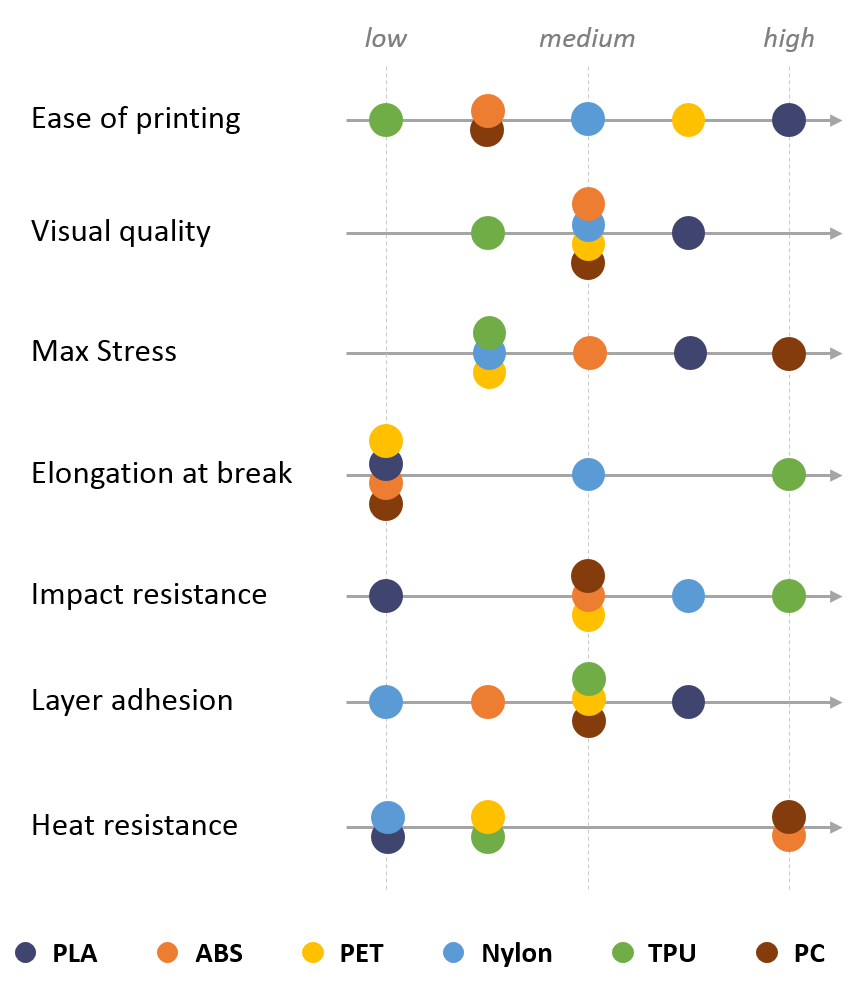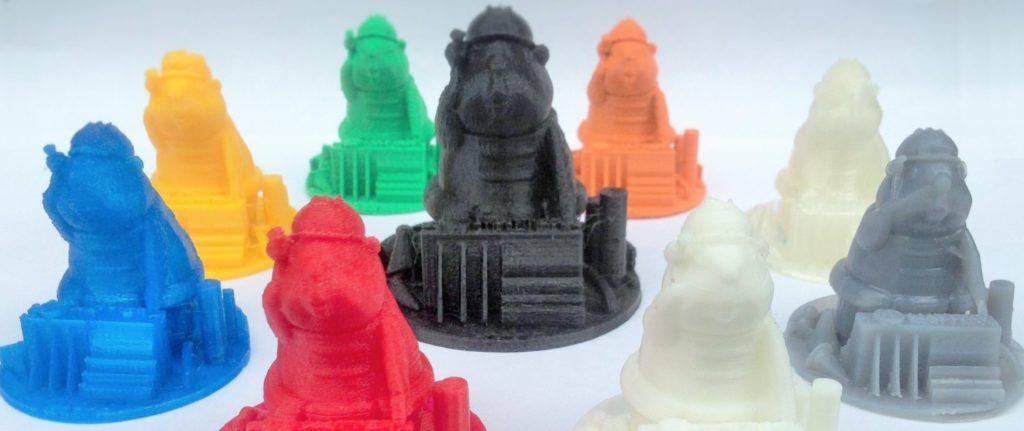 Back in April, at the Inside 3D Printing New York Conference and Expo, we had the chance to cover the Frontier Tech Startup Showdown, an exciting competition between the newest and most innovative 3D printing startups from all around the world. One of the seven young companies participating in the competition was New York City-based 3D Matter, a startup looking to forecast properties of 3D printing materials to optimize the use of the emerging technology for functional products. Now, three months after introducing themselves at the Frontier Tech Startup Showdown, 3D Matter has released a comprehensive analysis on which polymer material should be used for certain 3D printing applications.
Back in April, at the Inside 3D Printing New York Conference and Expo, we had the chance to cover the Frontier Tech Startup Showdown, an exciting competition between the newest and most innovative 3D printing startups from all around the world. One of the seven young companies participating in the competition was New York City-based 3D Matter, a startup looking to forecast properties of 3D printing materials to optimize the use of the emerging technology for functional products. Now, three months after introducing themselves at the Frontier Tech Startup Showdown, 3D Matter has released a comprehensive analysis on which polymer material should be used for certain 3D printing applications.
In their latest report, 3D Matter breaks down the properties of a multitude of widely used printing materials, including PLA, ABS, PET, Nylon, TPU, and PC. The study begins by addressing the fact that, although ABS and PLA materials have dominated the plastic 3D printing materials market, there’s no reason why the lesser known materials shouldn’t be utilized just as much for certain applications. 3D Matter goes on to address the key differences and benefits in the properties of each of the aforementioned materials.
 Although their past studies are generally based on three primary categories — mechanical performance, visual quality, and process — this time around, 3D Matter decided to delve a bit deeper into each of these groups. And so, the 3D Matter team ended up with seven main categories, which consist of ease of printing, visual quality, max stress, elongation at break, impact resistance, later adhesion, and heat resistance. To portray the discovered data in a visually stimulating way, 3D Matter displayed their findings onto an array of colorful and easy-to-read charts.
Although their past studies are generally based on three primary categories — mechanical performance, visual quality, and process — this time around, 3D Matter decided to delve a bit deeper into each of these groups. And so, the 3D Matter team ended up with seven main categories, which consist of ease of printing, visual quality, max stress, elongation at break, impact resistance, later adhesion, and heat resistance. To portray the discovered data in a visually stimulating way, 3D Matter displayed their findings onto an array of colorful and easy-to-read charts.
 Unsurprisingly, 3D Matter found PLA (polylactic acid) to be the best-suited material for ease of printing, while also providing good visual quality. The experimentation also showed that, although PLA is both moderately rigid and strong, it is much more brittle than other polymer materials. In the case of ABS (acrylonitrile butadiene styrene), 3D Matter found that it’s the ideal material when high temperature resistance and higher toughness are required, but they did also note the potential for high fume emissions and odor with this material. The study cast a positive light on PET (polyethylene terephthalate) material, a slightly soft polymer with high humidity and chemical resistance that is easy to print, and also contains few drawbacks.
Unsurprisingly, 3D Matter found PLA (polylactic acid) to be the best-suited material for ease of printing, while also providing good visual quality. The experimentation also showed that, although PLA is both moderately rigid and strong, it is much more brittle than other polymer materials. In the case of ABS (acrylonitrile butadiene styrene), 3D Matter found that it’s the ideal material when high temperature resistance and higher toughness are required, but they did also note the potential for high fume emissions and odor with this material. The study cast a positive light on PET (polyethylene terephthalate) material, a slightly soft polymer with high humidity and chemical resistance that is easy to print, and also contains few drawbacks.
In the case of Nylon, 3D Matter found that this polymer type contains exceptional mechanical properties, and has the best impact resistance as far as non-flexible materials go. But, the material was also marked as potentially troubling when it layer adhesion is in the picture. For TPU (thermoplastic polyurethane), by far the most flexible material examined in the study, proved to have a very high impact resistance, making it useful for a wide-range of applications. Last but not least, the strongest material of them all, PC (polycarbonate), showed to relate closely to ABS, and could prove to be a more apt substitute for the more popularized odor and emission producing material.
 Although their most recent study is packed with valuable information on 3D printing polymers, 3D Matter does admit that many filament producers provide blends or add additives to modify these base properties, which were not covered in this particular research project. For those who wish to look into these blends and modified polymers, 3D Matter offers their OptiMatter platform, which helps users calculate the optimal printing configuration for their particular uses.
Although their most recent study is packed with valuable information on 3D printing polymers, 3D Matter does admit that many filament producers provide blends or add additives to modify these base properties, which were not covered in this particular research project. For those who wish to look into these blends and modified polymers, 3D Matter offers their OptiMatter platform, which helps users calculate the optimal printing configuration for their particular uses.
 Still, it’s important to note a few things that the study was not fully able clarify. For starters, little is known about the toxicity of these 3D printing polymers, which 3D Matter admits could play a bigger role in the near future. Additionally, the grades given represent the base chemistry of each material, and will not always precisely correspond with modified or blended materials offered by producers and suppliers. At the end of the day, the optimal polymer printing material depends on what the user is looking to print, and thus it is vital to understand what makes each plastic unique and beneficial. Let’s discuss further over in the 3D Matter & 3D Printing Polymers forum over at 3DPB.com.
Still, it’s important to note a few things that the study was not fully able clarify. For starters, little is known about the toxicity of these 3D printing polymers, which 3D Matter admits could play a bigger role in the near future. Additionally, the grades given represent the base chemistry of each material, and will not always precisely correspond with modified or blended materials offered by producers and suppliers. At the end of the day, the optimal polymer printing material depends on what the user is looking to print, and thus it is vital to understand what makes each plastic unique and beneficial. Let’s discuss further over in the 3D Matter & 3D Printing Polymers forum over at 3DPB.com.
Subscribe to Our Email Newsletter
Stay up-to-date on all the latest news from the 3D printing industry and receive information and offers from third party vendors.
You May Also Like
3D Printing Financials: Fathom Struggles in Financial Quicksand During Critical Transition
Facing a year of key transitions and financial pressures, Fathom (Nasdaq: FTHM) has filed its annual report for 2023 with the U.S. Securities and Exchange Commission (SEC). The document outlines...
Latest Earnings Overview for Australian 3D Printing Firms Titomic and AML3D
Australian 3D printing manufacturing firms Titomic (ASX: TTT) and AML3D (ASX: AL3) reported their financial results for the period from July to December 2023, marking the first half of their...
3D Printing Webinar and Event Roundup: April 7, 2024
Webinars and events in the 3D printing industry are picking back up this week! Sea-Air-Space is coming to Maryland, and SAE International is sponsoring a 3D Systems webinar about 3D...
3D Printing Financials: Unpacking Farsoon and BLT’s 2023 Performance
In the Chinese 3D printing industry, two companies, Farsoon (SHA: 688433) and Bright Laser Technologies, or BLT (SHA: 688333), have recently unveiled their full-year earnings for 2023. Farsoon reported increases...































